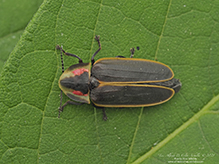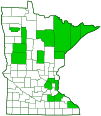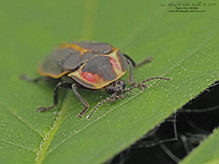spring tree-top flasher
(Pyractomena borealis)
Conservation • Description • Habitat • Ecology • Distribution • Taxonomy
|
|
||||||||||||||
Description |
Spring tree-top flasher is a large, early season, typical firefly. It occurs in the United States east of the Great Plains, and in southern Canada from Nova Scotia to Alberta. It is the largest and the second most common of the 16 Pyractomena species. In most areas, spring tree-top flasher is the first firefly to emerge in the spring. In Minnesota, adults are active at dusk in May and early June. They are found in many habitat types, including deciduous, coniferous, and mixed forests, and in field margins. They are seen flying among treetops and at field edges. They do not feed. The larvae are terrestrial. They feed on snails and other invertebrates. Adults are 7⁄16″ to ¾″ (11 to 19 mm) in length. The body is soft, firm, elongated oval, almost parallel sided, and flattened. The head is black and is strongly curved downward. It can be retracted and completely concealed beneath the plate covering the first segment of the thorax (pronotum). The eyes are relatively large, especially on the male. The mouthparts are directed downwards. The antennae are black and slender, not sawtoothed. They have 11 segments and are as long as the pronotum. The third through eleventh segments are 1.5 to 2 times longer than wide. The pronotum is wider than long. It has a ridge (carina) down the middle, but the carina is weak and does not reach the front margin. The lateral margins are distinctly flattened (margined). The rear margin is shallowly convex, and it usually distinctly angles outward at each corner. There is a broad black stripe down the middle that narrows to the front margin and often abruptly widens at the rear margin. The black stripe is bordered with a reddish stripe, at least on the rear half. The sides are yellowish and there is almost always a black stripe on each lateral margin. The plate between the wing bases (scutellum) is visible and black. The underside of the thorax is brownish black except for the first segment (prothorax), which is reddish. The wing covers (elytra) are brownish black. The sides gradually widen from the base, are parallel in the middle, then gradually narrow to the tip. Each elytron has two or three well-defined longitudinal ridges, a pale border that is often very narrow, and a pale border on the inner margin. The surface is finely roughened (granulate), and it is not pitted (punctate). It is covered with two kinds of hairs (pubescence). The primary pubescence is conspicuous and of equal length across the entire surface. The secondary pubescence covers three fourths or more of the surface. This feature helps distinguish this firefly from other species in the same genus. The underside of the abdomen is brownish black except for the fifth and sixth segments, which are entirely dull yellow on the male, dull yellow with a dark spot in the middle on the female. Light emitting organs are well developed in both sexes. The legs are black. The last part of each leg (tarsus), corresponding to the foot, has five segments. There is a pair of claws at the end of the last segment. On the front and middle legs, the front claws are not toothed or split. |
Size |
Total length: 7⁄16″ to ¾″ (11 to 19 mm) |
Flash Pattern |
The male’s flash is amber. The flash pattern begins about 32 minutes after sunset and continues for about 20 minutes. The pattern almost always consists of just a single, 0.20- to 0.25-second long flash. In the rare occurrences where there are two flashes, the interval between flashes is 0.60 second. The interval between flash patterns is 3.6 to 4.2 seconds at 64° to 68° F (18° to 20° C). |
Similar Species |
Habitat |
Deciduous, coniferous, and mixed forests; field margins |
Ecology |
Season |
May and early June |
Behavior |
Males fly at dusk |
Life Cycle |
The female lays a clutch of up to 100 eggs in cracks in tree bark. There are five larval stages (instars). The first four instars last less than 20 days each. The fifth instar overwinters on tree bark, usually 2 to 5 feet above the ground and with southern exposure to the winter sun. It hangs in a head down position, clinging to the tree bark with its hold fast organ. It pupates in the early spring, also in a head down position 2 to 5 feet above ground, clinging with its hold fast organ to its shed larval skin (exuvium), which is firmly glued to the tree bark. Adults emerge in 5 to 14 days. Mating occurs soon after emergence. |
Larva Food |
Snails and other soft-bodied invertebrates |
Adult Food |
Adults do not feed. |
Distribution |
||
|
Sources Revision of the Nearctic species of Pyractomena. Green, J.W. 1957. Wasmann Journal of Biology 15(2): 237-284. |
|
| 4/5/2024 | ||
Occurrence |
||
Common |
||
Taxonomy |
|
Order |
Coleoptera (Beetles) |
Suborder |
Polyphaga (Water, Rove, Scarab, Long-horned, Leaf, and Snout Beetles) |
Infraorder |
Elateriformia |
Superfamily |
Elateroidea (click, firefy, and soldier beetles) |
Family |
|
Subfamily |
Lampyrinae (typical fireflies) |
Tribe |
Cratomorphini |
Genus |
Pyractomena |
Subordinate Taxa |
|
|
|
Synonyms |
|
Lampyris borealis |
|
Common Names |
|
spring tree-top flasher |
|
Glossary
Elytra
The hardened or leathery forewings of beetles used to protect the fragile hindwings, which are used for flying. Singular: elytron.
Instar
The developmental stage of arthropods between each molt; in insects, the developmental stage of the larvae or nymph.
Pronotum
The exoskeletal plate on the upper side of the first segment of the thorax of an insect.
Pubescence
On plants: the fuzzy hairs on a leaf, bud, stem, fruit, flower, or other structure. On insects and arachnids: the hair-like processes (setae) on the body.
Punctate
Dotted with pits (punctures), translucent sunken glands, or colored spots of pigment.
Scutellum
The exoskeletal plate covering the rearward (posterior) part of the middle segment of the thorax in some insects. In Coleoptera, Hemiptera, and Homoptera, the dorsal, often triangular plate behind the pronotum and between the bases of the front wings. In Diptera, the exoskeletal plate between the abdomen and the thorax.
Tarsus
On insects, the last two to five subdivisions of the leg, attached to the tibia; the foot. On spiders, the last segment of the leg. Plural: tarsi.
Visitor Photos |
||
Share your photo of this insect. |
||
This button not working for you? |
||
Alfredo Colon |
||
 |
 |
|
 |
||
MinnesotaSeasons.com Photos |
||
|
||
|
||

Slideshows |
|

Visitor Videos |
||
Share your video of this insect. |
||
This button not working for you? |
||
|
Other Videos |
||
Firefly (Lampyridae: Pyractomena borealis) on Grassblade |
About
Jun 5, 2010 Photographed at Turtle River State Park, North Dakota (04 June 2010). Go here to see other images of this species: http://bugguide.net/node/view/307318 |
Pyractomena borealis larva feeding on maple sap, Monroe Co 22 Jan 2018 |
About
Dec 13, 2018 Pyractomena borealis larva feeding on maple sap, Monroe Co. 22 Jan 2018 |

Created: 4/5/2024 Last Updated: © MinnesotaSeasons.com. All rights reserved. |




